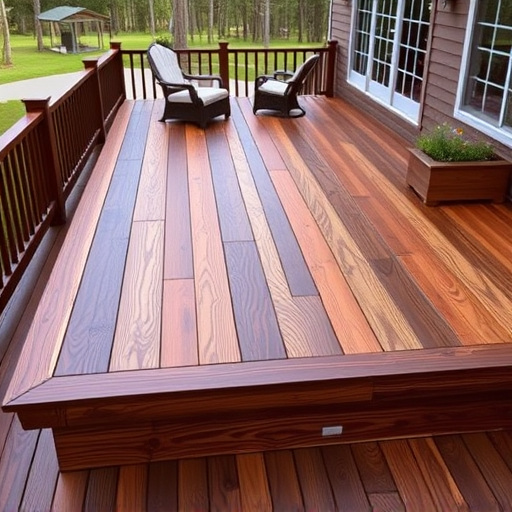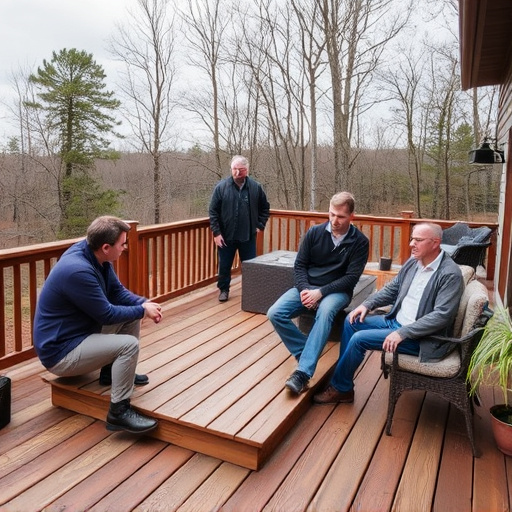Transform Your Backyard with Stylish and Durable Outdoor Deck Ideas
Unleash the potential of your backyard with these innovative outdoor deck ideas. Designing a functio…….
In today’s rapidly urbanizing world, the concept of an outdoor deck has emerged as a vital element in enhancing residential and commercial spaces. An outdoor deck is more than just an extension of indoor living; it is a seamless transition between architecture and nature, offering a tranquil retreat amidst the hustle and bustle of city life. This article aims to provide an in-depth exploration of outdoor decks, delving into their history, global impact, economic significance, technological innovations, regulatory frameworks, challenges, and future prospects. By the end of this journey, readers will gain a comprehensive understanding of why outdoor decks are not just a trend but a transformative force shaping our built environment.
An outdoor deck, in its essence, is a structured, elevated or ground-level exterior space attached to a building, designed to facilitate social interaction, relaxation, and an appreciation for the outdoors. It serves as a bridge between indoor comfort and natural environments, offering residents and visitors alike a place to unwind, entertain, or simply savor the beauty of nature.
Core Components:
Historical Context:
The concept of outdoor decks can be traced back to ancient civilizations, where people would gather on terraces and rooftops for social events and stargazing. However, it was in the mid-20th century that decks began to evolve into a prominent feature in residential construction, especially in regions with milder climates. The rise of DIY culture and advancements in building materials further popularized decks, allowing homeowners to create personalized outdoor spaces.
The influence of outdoor decks is not limited to specific regions; it has become a global phenomenon, adapting to diverse cultural and climatic contexts.
International Influence:
Key Global Trends:
| Trend | Description |
|---|---|
| Sustainability Focus | There is a growing trend towards using eco-friendly materials, such as recycled plastics and bamboo, to create durable and aesthetically pleasing decks. |
| Integration with Smart Homes | Technological advancements enable deck spaces to be connected to smart home systems, allowing for automated lighting, music, and temperature control. |
| Elevated Luxury | High-end properties often feature lavish decks with custom designs, high-quality materials, and luxurious amenities like hot tubs and outdoor kitchens. |
| Urban Green Spaces | In densely populated cities, rooftop and balcony decks contribute to urban greening, providing residents with access to green spaces and improving overall well-being. |
The outdoor deck industry is a significant contributor to the global construction and home improvement market, with a substantial economic impact on various sectors.
Market Size and Growth:
According to a 2022 report by Market Research Future (MRFR), the global outdoor decking market is projected to reach USD 13.5 billion by 2027, growing at a CAGR of 6.2% from 2020 to 2027. This growth can be attributed to increasing disposable income, urbanization, and a growing preference for outdoor living.
Investment Patterns:
Economic Benefits:
Technological innovations have played a pivotal role in transforming outdoor decks into smart, efficient, and enjoyable spaces.
Smart Home Integration:
Material Innovations:
Future Potential:
The future of outdoor decks lies in seamless integration with emerging technologies:
The development and maintenance of outdoor decks are subject to various policies and regulations, ensuring safety, environmental protection, and quality construction.
Building Codes:
Local building codes dictate deck dimensions, structural requirements, fire safety measures, and permitted materials. These codes vary across regions, influencing deck design and construction practices.
Environmental Regulations:
Industry Standards:
Voluntary industry standards, such as those set by the American Society for Testing and Materials (ASTM), provide guidelines for deck construction, ensuring product quality and safety. These standards cover everything from decking materials to handrail requirements.
Despite their numerous benefits, outdoor decks face several challenges and criticisms that require careful consideration and strategic solutions.
Main Challenges:
Criticisms and Solutions:
Real-world applications of outdoor decks offer valuable insights into successful design, functionality, and community integration.
Case Study 1: The Urban Oasis (New York City)
In the bustling heart of Manhattan, a rooftop deck transformation created an urban oasis for residents of a high-rise apartment building. Designed by landscape architects, the deck features:
Case Study 2: Sustainable Resort Deck (Bali)
A luxury resort in Bali embraced sustainability with its outdoor deck design, setting a new standard for eco-friendly hospitality. Key features include:
The future of outdoor decks is filled with exciting possibilities, driven by technological advancements, evolving consumer preferences, and environmental considerations.
Potential Growth Areas:
Emerging Trends:
Strategic Considerations for Businesses:
The journey through the world of outdoor decks has revealed their profound impact on modern living, offering solutions for entertainment, relaxation, and environmental stewardship. From historical roots to global trends, technological advancements, and regulatory frameworks, outdoor decks have evolved into sophisticated, multifunctional spaces.
As we look towards the future, the potential for outdoor decks to enhance our lives remains vast. By embracing sustainable practices, integrating smart technologies, and prioritizing accessibility, these exterior retreats can become even more inclusive and efficient. The ongoing evolution of deck design and construction will undoubtedly shape our urban and suburban landscapes, providing a harmonious connection between humans and nature for generations to come.
Q: How do I choose the right decking material?
A: The best material depends on your climate, budget, and desired maintenance level. Wood offers natural beauty but requires regular care; composite materials are low-maintenance; and concrete is durable with minimal upkeep.
Q: Are outdoor decks subject to local regulations?
A: Absolutely! Building codes, zoning laws, and environmental regulations govern deck construction to ensure safety, privacy, and aesthetic harmony with surrounding areas. Always check local requirements before starting a project.
Q: Can I transform my balcony into a deck?
A: Yes, with some creativity and the right materials. Balconies can be transformed into cozy outdoor retreats using rails, canopy roofs, and suitable flooring options. Ensure your balcony structure can support the additional weight.
Q: How do I make my deck more accessible for people with disabilities?
A: Consider lower rail heights, wide walkways, and slip-resistant surfaces to ensure ease of access. Ramps or lifts may be necessary for significant height differences. Consult accessibility guidelines for specific recommendations.
Q: What are some cost-effective ways to enhance my deck’s appearance?
A: Regular cleaning and sealing extend the life of your deck. Adding potted plants, outdoor rugs, or comfortable seating can instantly upgrade its aesthetic appeal without breaking the bank.

Unleash the potential of your backyard with these innovative outdoor deck ideas. Designing a functio…….

An outdoor deck is a versatile space that transforms your home into an entertainment hub or relaxati…….